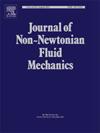聚合物熔体流动的量纲分析及分子动力学模拟验证
IF 2.8
2区 工程技术
Q2 MECHANICS
引用次数: 0
摘要
众所周知,在风洞模拟过程中,只要保持雷诺数不变,就可以用小尺寸模型机翼模拟大尺寸真实机翼,得到相似的流场。我们从中得到启发,在粘弹性流体的流动中,如聚合物熔体注射过程中,模具对应于一个风洞,也有一个流场。由于聚合物熔体是粘弹性流体,不同于空气,所以应该有另一个物理量与雷诺数相对应。通过量纲分析,我们发现它是Weissenberg数,Wi (=vτ/z)。在Wi不变的情况下,改变注射速度v、改变聚丙烯熔体弛豫时间τ或改变模具尺寸z,流场的几何形状都是相似的。事实上,在聚合物加工中改变模具的尺寸并不是一件容易的事。因此,我们首先进行了介观尺度的尺寸分析,然后进行了介观尺度的分子动力学模拟。仿真结果验证了量纲分析的结论,因此我们有理由相信该结论在宏观尺度上是正确的,我们期望在未来通过改变模具尺寸和注射速度来验证它。在未来,我们将使用这种方法来了解聚合物熔体在模具中的流动,这可能会增强我们对模具内熔体流动不稳定性的理解。本文章由计算机程序翻译,如有差异,请以英文原文为准。
Dimensional analysis and the validation by molecular dynamics simulation of polymer melt flow
As well known, in the simulation process of wind tunnel, as long as the Reynolds number is kept constant, a small-sized model wing can be used to simulate a large-sized real wing and obtain similar flow fields. We draw inspiration from it that in the flow of viscoelastic fluid, such as the process of polymer melt injection, the mold corresponds to a wind tunnel, and there is also a flow field. Since the polymer melt is a viscoelastic fluid and is different from air, there should be another physical quantity corresponding to the Reynolds number. By dimensional analysis, we find that it is the Weissenberg number, . If remains constant, changing the injection speed , changing the relaxation time of the polypropylene melt , or changing the size of the mold will result in a similar geometric shape of the flow field. In fact, changing the size of the mold in polymer processing is not an easy task. Therefore, we first conduct mesoscopic scale dimensional analysis and then perform mesoscopic scale molecular dynamics simulation. The simulation results verify the conclusion of the dimensional analysis, so we have reason to believe that the conclusion is correct at the macroscopic scale, and we expect to verify it in the future by changing the mold size and injection speed. In the future, we will use this method to understand the flow of polymer melt in the mold, which may enhance our understanding of melt flow instability within the mold.
求助全文
通过发布文献求助,成功后即可免费获取论文全文。
去求助
来源期刊
CiteScore
5.00
自引率
19.40%
发文量
109
审稿时长
61 days
期刊介绍:
The Journal of Non-Newtonian Fluid Mechanics publishes research on flowing soft matter systems. Submissions in all areas of flowing complex fluids are welcomed, including polymer melts and solutions, suspensions, colloids, surfactant solutions, biological fluids, gels, liquid crystals and granular materials. Flow problems relevant to microfluidics, lab-on-a-chip, nanofluidics, biological flows, geophysical flows, industrial processes and other applications are of interest.
Subjects considered suitable for the journal include the following (not necessarily in order of importance):
Theoretical, computational and experimental studies of naturally or technologically relevant flow problems where the non-Newtonian nature of the fluid is important in determining the character of the flow. We seek in particular studies that lend mechanistic insight into flow behavior in complex fluids or highlight flow phenomena unique to complex fluids. Examples include
Instabilities, unsteady and turbulent or chaotic flow characteristics in non-Newtonian fluids,
Multiphase flows involving complex fluids,
Problems involving transport phenomena such as heat and mass transfer and mixing, to the extent that the non-Newtonian flow behavior is central to the transport phenomena,
Novel flow situations that suggest the need for further theoretical study,
Practical situations of flow that are in need of systematic theoretical and experimental research. Such issues and developments commonly arise, for example, in the polymer processing, petroleum, pharmaceutical, biomedical and consumer product industries.

 求助内容:
求助内容: 应助结果提醒方式:
应助结果提醒方式:


